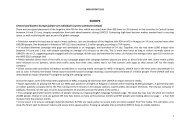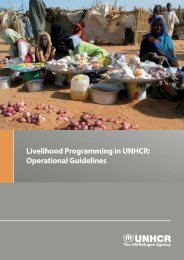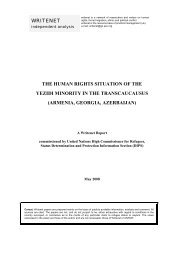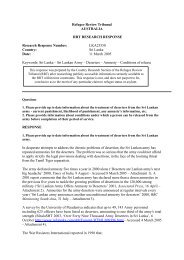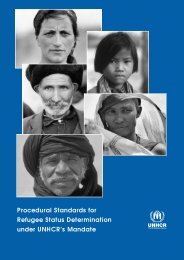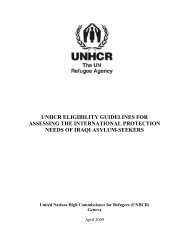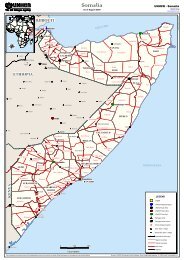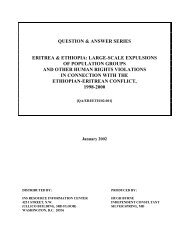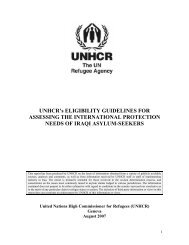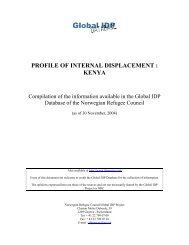CONCLUSIONS ADOPTED BY THE EXECUTIVE ... - UNHCR
CONCLUSIONS ADOPTED BY THE EXECUTIVE ... - UNHCR
CONCLUSIONS ADOPTED BY THE EXECUTIVE ... - UNHCR
Create successful ePaper yourself
Turn your PDF publications into a flip-book with our unique Google optimized e-Paper software.
1994 (Executive Committee—45 th Session)<br />
1967 Protocol, depending on the particular circumstances, they nonetheless are often in need of international<br />
protection, humanitarian assistance and a solution to their plight;<br />
(m) Recalls that <strong>UNHCR</strong> has often been requested by the United Nations General Assembly to extend<br />
protection and assistance to persons who have been forced to seek refuge outside their countries of origin as a<br />
result of situations of conflict, and encourages the High Commissioner to continue to provide international<br />
protection to such persons, and to seek solutions to the problems arising from their forced displacement, in<br />
accordance with relevant General Assembly resolutions, and calls upon all States to assist and support the High<br />
Commissioner's efforts in this regard;<br />
(n) Recognizes that in Africa and Latin America, regional instruments provide for the protection of<br />
refugees fleeing armed conflict and civil strife, as well as those fearing persecution, and that in other regions,<br />
persons who require international protection, but who either are not considered refugees within the scope of the<br />
1951 Convention and 1967 Protocol or are in countries that have not acceded to these instruments, have<br />
generally been provided protection and humanitarian assistance through specific measures adopted by States and<br />
in full cooperation with <strong>UNHCR</strong>;<br />
(o) Recognizes the desirability of exploring further measures to ensure international protection to all who<br />
need it;<br />
(p) Acknowledges the value of regional harmonization of national policies to ensure that persons who are<br />
in need of international protection actually receive it, and calls upon States to consult <strong>UNHCR</strong> at the regional<br />
level in achieving this objective;<br />
(q) Encourages the High Commissioner to continue to promote international cooperation in providing<br />
international protection to all who require it, and to engage in further consultations and discussions concerning<br />
measures to achieve this objective, which might involve the elaboration of guiding principles, including for<br />
concerted action;<br />
(r) Considers that temporary protection, which has been described by the High Commissioner in the<br />
context of the Comprehensive Response to the Humanitarian Crisis in the former Yugoslavia as including<br />
admission to safety, respect for basic human rights, protection against refoulement, and safe return when<br />
conditions permit to the country of origin, can be of value as a pragmatic and flexible method of affording<br />
international protection of a temporary nature in situations of conflict or persecution involving large-scale<br />
outflows;<br />
(s) Welcomes the further exploration by the High Commissioner, pursuant to Protection Conclusion (m)<br />
(1993), of temporary protection as an asylum strategy, in the context of addressing prevention, protection and<br />
solutions on a comprehensive regional basis, and looks forward to further discussions among interested<br />
Governments on this subject, including the duration of temporary protection;<br />
(t) Notes that the beneficiaries of temporary protection may include both persons who qualify as refugees<br />
under the terms of the 1951 Convention and the 1967 Protocol and others who may not so qualify, and that in<br />
providing temporary protection States and <strong>UNHCR</strong> should not diminish the protection afforded to refugees<br />
under those instruments;<br />
(u) Calls upon <strong>UNHCR</strong>, in close cooperation with the Governments concerned, to continue to coordinate<br />
and to provide guidance concerning the implementation of temporary protection and other forms of asylum<br />
oriented towards repatriation, in situations where return home is considered the most appropriate durable<br />
solution, including advice on voluntary repatriation and on safe return once the need for international protection<br />
has ceased;<br />
(v) Reiterates that voluntary repatriation, when it is feasible, is the ideal solution to refugee problems, and<br />
calls upon countries of origin, countries of asylum, <strong>UNHCR</strong> and the international community as a whole to do<br />
everything possible to enable refugees to exercise freely their right to return home in safety and dignity;<br />
(w) Notes that numerous obstacles to voluntary repatriation have been encountered, including threats to the<br />
safety of repatriating refugees both in countries of asylum and countries of origin and the persistence or<br />
recrudescence of conditions causing refugee flight;<br />
(x) Stresses in this connection the responsibilities of States of origin to readmit their nationals and to<br />
ensure their safety and welfare, and of countries of asylum to provide for the security and safeguard the<br />
fundamental rights of refugees, and calls upon the international community to assist States to discharge these<br />
responsibilities with respect to refugees and returnees;<br />
104




